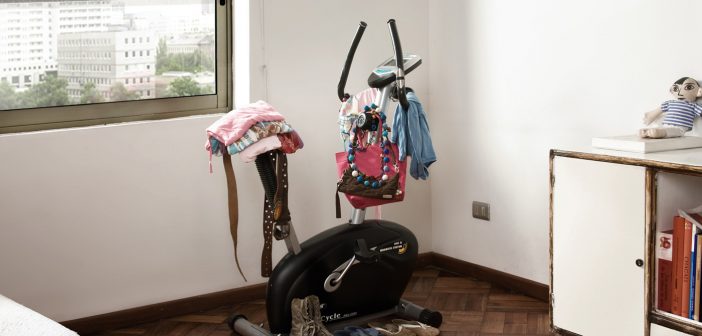Let’s be real: How many of us have a stationary bike or treadmill that’s now a glorified laundry hanger? Or a dusty set of bands and a sad pair of dumbbells stuffed behind the couch? Or a kettlebell that now props open the kitchen door?
Working out at home is touted as a great option for busy parents. The reality, however, is that most people who try it very quickly lose motivation and quit. Well, turns out that there are pretty major mistakes we all make with home workouts. And they have a lot to do with why we can’t stay on the proverbial treadmill long enough to get results.
We got the low down from Beijing fitness pros on the top six things we mess up, and what we should do instead to move the needle on our fitness.
1. Not having a specific goal.

A leaderboard at Warrior One. Putting numbers and targets give people goalposts to keep them on track. Image courtesy of Warrior One.
Most people say “I want to lose weight” or “I want to get fit.” But there’s nothing specific or measurable about these goals, and no timeline attached to them. “If you don’t define a goal, it’s impossible to measure the results of your workout,” says Suba Dangol, a 20-year veteran of the Beijing fitness industry. “Without concrete measures of progress, it’s very hard to stay motivated.”
Start with a short-term goal: Lose 1-2 pounds a week; Do 12 good pushups consecutively within six weeks; Run consistently for nne kilometer in a month; Work up to a 1-minute plank. Be specific and start small.
2. Not having a plan.

Wanna bench 90kgs in 4 months’ time like Phil here? You’ll need a solid plan. Image courtesy of Warrior One.
Just like you can’t learn a language by opening a bilingual dictionary and randomly memorizing words with no structure or plan, you can’t improve your fitness by doing a bunch of workouts without logical programming behind it. “If you ‘just exercise,’ you improve a bit in the beginning but stall out very quickly, which will cause you to quit,” says Wes de Kirby, a strength and conditioning specialist at Warrior One.
“There is a science to fitness,” de Kirby continued. “Weight loss is about consistently maintaining the math of calorie intake vs. calories burned. Novice strength gains are about incrementally increasing weight or reps. It’s all logical programming, and it’s as true for athletes and pros as it is for a middle-aged mom just starting to work out.” So instead of jumping on random high-intensity interval training (HIIT) workouts, or doing a bit of this or that without knowing where it will go, have a simple but logical plan that moves you towards your specific goal.
3. Chasing pain instead of progress.

A screenshot of a NY Times article from 2014 breaks down the “No Pain, No Gain” adage in the fitness industry.
Many jump on crash diets and excessive exercise plans. Before long, they are fatigued, injured, and still without the results they want. So they end up quitting. “Part of the problem is people think ‘No Pain, No Gain,’ and they measure workouts by how they feel and not what they produce,” says de Kirby. “Popular workout culture, which glorifies soreness, tells people that they have to suffer greatly. This is simply not true.” When making a fitness plan and defining your goals, don’t measure the suffering you can inflict on yourself, says de Kirby. “Instead, measure the progress you are able to make.”
4. Doing workouts they hate.

Training online is much easier now.
Over the last decade or so, online training options got a lot more diverse.
If you hate traditional workouts, try something fun instead. Dance fitness and combat cardio have been around for as long as Jane Fonda, Richard Simmons, and Billy Blanks have graced our TV screens. And now there are many more options that focus on learning skills while still getting you to improve your fitness. A quick search on YouTube results in self-training for Muay Thai, boxing, jiujitsu, salsa, jazz, African dance, and so much more. Explore what piques your interest and get started. As a bonus, skill-based training typically has built-in goals and progression, which help keep you motivated.
5. Not scheduling or holding yourself accountable.

Schedule your workouts for more accountability. @ColleenWait via Twenty20
Put workouts in your calendar just like you would meetings. Set a time that won’t be interrupted by a) family, b) work, c) household chores, or d) your social life. It might be one weekday and one weekend. Or, if you’re a morning person, 20 minutes at the start of the day. If you work from home or have space in your office, pencil in during lunchtime. Also, get an accountability partner: your spouse, your friend, or even a support group online. If you’ve got to answer to someone else, you’re more likely to stay on track than if it’s just to yourself.

Oh well, I guess this means I can’t work out. @starryskyes0204 via Twenty20
6. Thinking they have to DIY it.

Alena, one of De Kirby’s trainees, works with him in person twice a week and once a week on her own at her school’s gym. Image courtesy of Warrior One.
Home workouts don’t have to be DIY. You can work with a coach in person once or twice a week (at the gym or at your home), and do home workouts the rest of the time. This helps on multiple fronts: if you have a specific goal, a coach will know how to make tailored programming for it and keep you accountable along the way. Coaches also help you troubleshoot and avoid serious injury. “People often don’t realize when they’re doing something wrong,” says Dangol. “They sometimes follow online programs without first considering if it’s actually suitable for them. If you’ve never worked out a day in your life and start doing 100 burpees because that’s what you saw on TikTok, you will likely end up damaging your joints.” Work with a private trainer (PT) who can program home workouts. Alternatively, join short-term group training sessions run online by reputable coaches. Either way, these can kickstart your training with less fuss and less time wasted on the “YouTube research” rabbit hole.
So with this in mind, give home workouts another go, and we’ll see you when you get to your goals.

A phone and mat may be all you need to challenge yourself. @sashapritchard via Twenty20
Here’s a super simple and sensible DIY home workout to get you started, courtesy of de Kirby!
-Set a timer for anywhere from 2-10 minutes. If you’re new, set it at two minutes.
-Pick 3-5 bodyweight exercises that you will do (push ups, air squat, lunges, jumping jacks, burpees, glute bridges, lying leg raises, YTW, McGill Big Three, etc.)
-Your goal will be to do as many reps of these exercises in the time you set.
-Rest about three minutes between each exercise.
-To progress, you can either increase the time for each exercise, or complete more reps within the original time frame.
KEEP READING: With E-Learning Comes E-xercise! Online Workouts To Stay In Shape
Images: Yonina Chan, various



